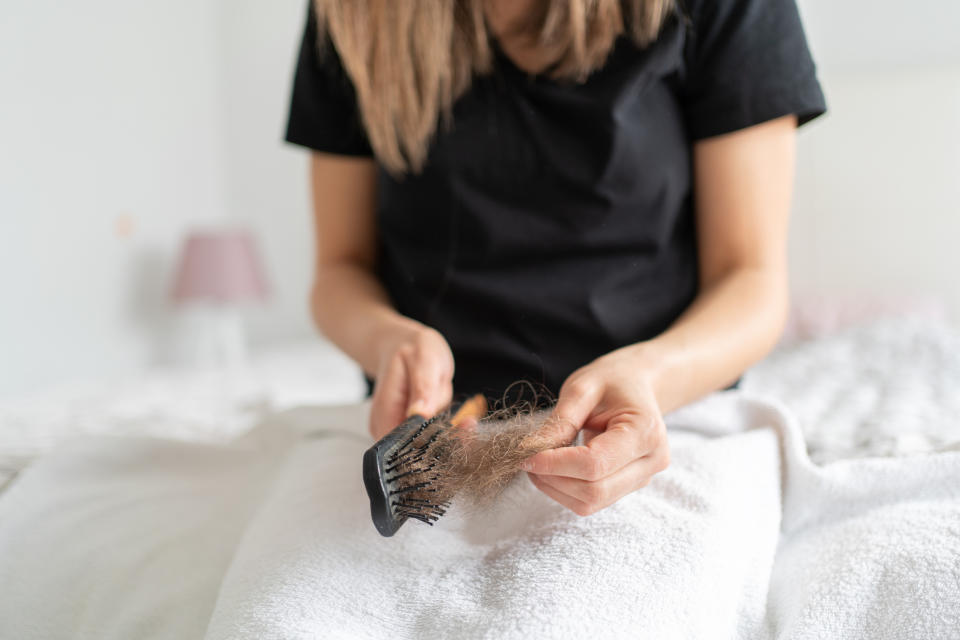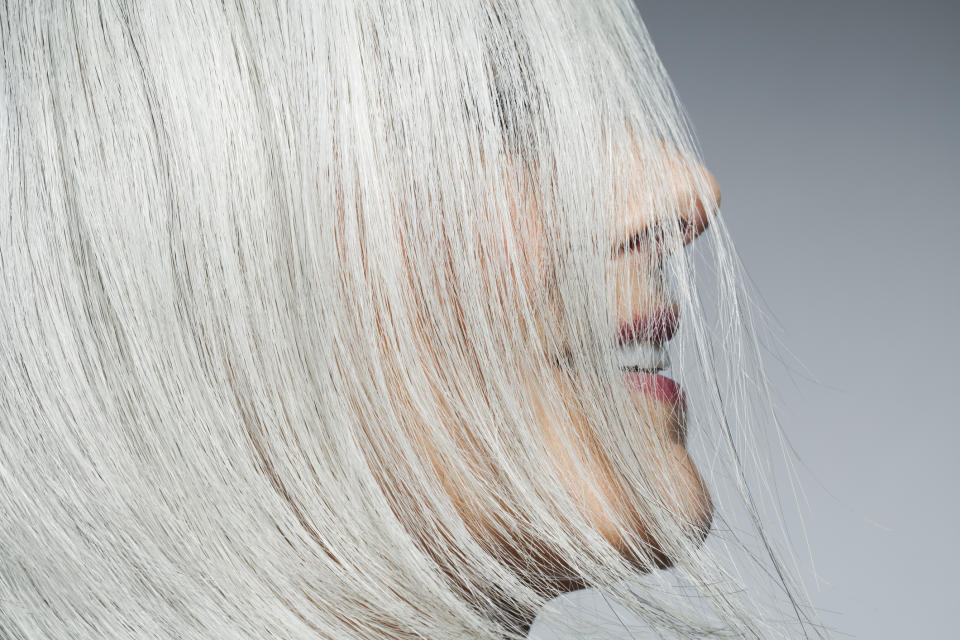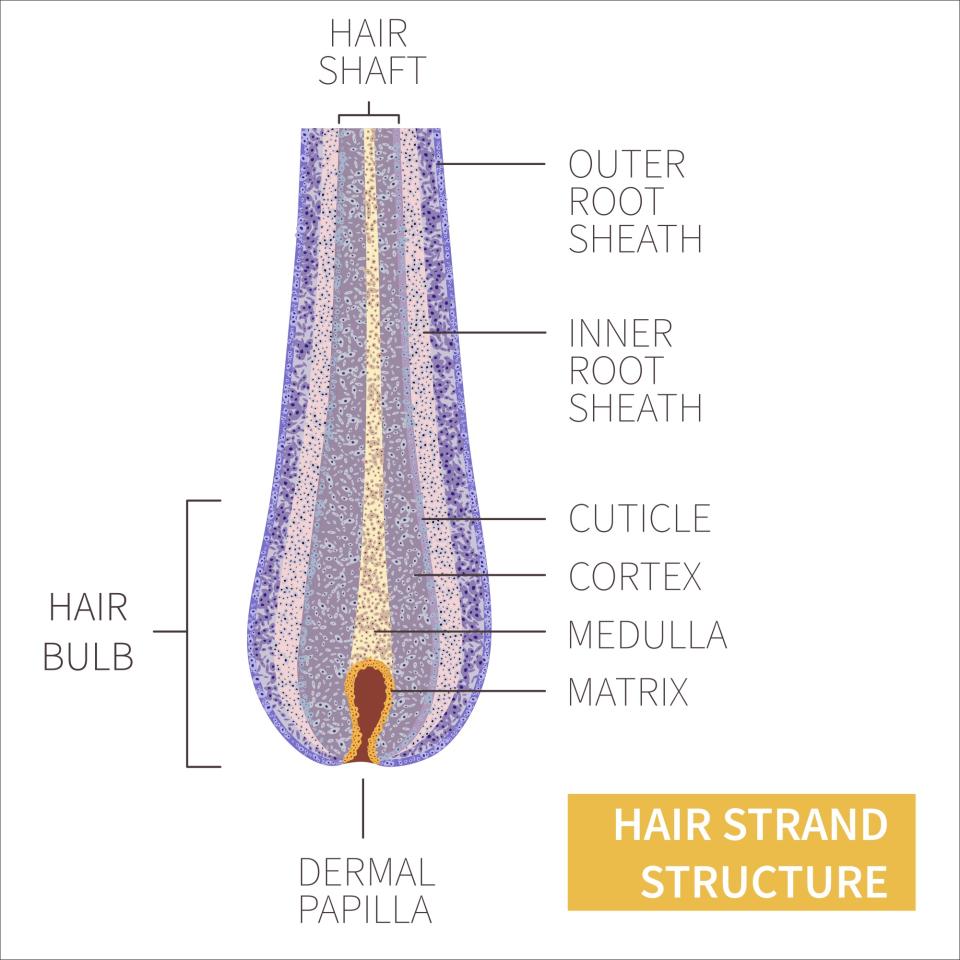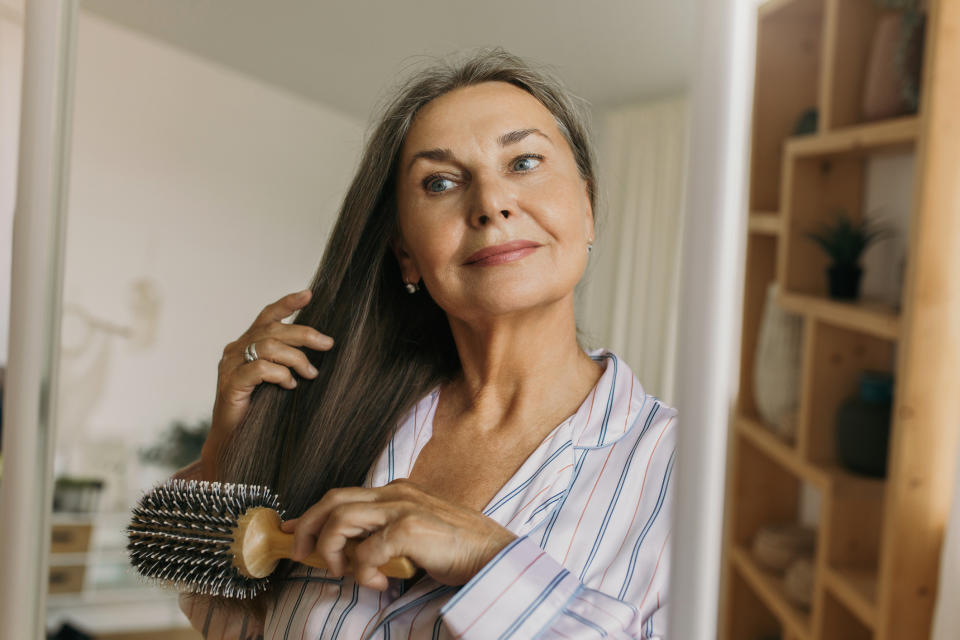Understanding the Hair Growth Cycle Can Help Pinpoint Why Your Hair Is Thinning
Worrying about your hair because you’ve noticed signs of thinning? Are there more strands in your shower drain, is your hairbrush filling up more quickly and/or is your part widening? If so, you’re far from alone. But thankfully, understanding the hair growth cycle can be a key factor in figuring out how to combat hair loss. Here, top MDs explain the make up of hair, the hair growth cycle and more so you're more knowledgeable about thinning hair.
How common is hair loss?
“Hair thinning is much more common than most realize,” shares Samuel M. Lam, MD, hair transplant surgeon and founder of the Lam Institute for Hair Restoration in Plano, Texas. Indeed, it may be surprising to discover just how many of us are dealing with excessive hair shedding. Says Dr. Lam: “30% of women over 30 have signs of hair thinning.” And studies show that this number climbs with the passing years, impacting 40% of us in our 40s and 52% of us in our 50s. “In fact, age-related hair loss impacts everyone to some degree,” notes Mark Nestor, MD, PhD, a board-certified dermatologist and director of the Center for Clinical and Cosmetic Research in Aventura, Florida.
Related: Menopause Hair Care: What Works Best for Women Over 50, According to Hair Pros

How hair loss impacts women
Yet, despite the vast number of us who are dealing with thinning hair, many suffer in lonely silence. “Hair loss can feel isolating,” says Natalie Kash, MD, a board-certified dermatologist and co-founder of Root Hair Institute in Bellevue, Washington. “In fact, studies have shown it can also impact an individual’s self-esteem, social relationships and career. This matches with many of my patients’ experiences who have shared that their hair loss affects their confidence, emotional health, relationships and even their professional performance.”
Women are also less likely to talk to their peers about their hair thinning than men, notes Dr. Kash. As a result, instead of asking around about treatments that family and friends are using, they stay mum and just try to cover up the thinning. Thankfully, there’s no need for anyone to continue hiding in shame. That’s because there are proven, easy treatments for most types of excessive hair shedding in women. Finding out the right one for you starts with knowing the basics about hair structure and how hair grows.
Related: 11 Best Hair Growth Products for Women Over 50 to Treat Thinning, According to Hair Loss Experts
What exactly is hair?

When most of us talk about our hair, we’re usually referring to the shaft, which is the strand that you can see outside the scalp. While this portion of hair grows in a wide variety of shades and textures, differing from person to person, hair has the same components for all of us. “Hair is essentially made of the protein -keratin — approximately 90%,” says trichologist David H. Kingsley, PhD, a hair loss specialist in New York City. “The remaining 10% or so of the hair fiber is made up of melanin — which is the pigment that gives hair its color — fats and oils, trace metals and water.”
The diameter of each hair strand is so tiny (a scant .017mm to .181mm thick) that we use the term “a hair’s breadth” to describe something infinitesimally small. Yet a single strand of hair is still wide enough to contain a complex set of parts.
“The hair shaft itself can be divided into three layers from outside in, which include the cuticle, cortex and medulla,” says Dr. Kash. “The cuticle acts as a layer of protection for the inner portions of the hair shaft. The cortex has the pigment and moisture of the hair. The medulla is the innermost portion in terminal (thick) hair and is typically absent in vellus (fine, short, wispy) hair.”

What is the hair follicle and root of hair?
Beneath the surface of the skin on your scalp is the hair follicle, which is the tube-shaped sac that produces the hair shaft and anchors it into place. The hair follicle is a complex mini organ that is part of the epidermis (top skin layer) but extends through the dermis (middle layer of skin) into the subcutaneous tissue (inner layer of skin), explains Kingsley.
“The part that nourishes the hair is in the bulb region — the ‘root’ that some people can see if their hair falls out,” he adds. It contains the dermal papilla, which delivers the blood supply through capillaries (tiny blood vessels), and the matrix, which consists of cells called keratinocytes that produce keratin needed to form hair strands. As more keratin forms, the hair grows and sprouts out of the scalp, where it' can be seen's visible to the eye. And surrounding the follicle are two protective layers consisting of the inner root sheath and outer root sheath.
The root cause of thinning hair
Noting how your hair is thinning can play an important role in figuring out if it’s due to a problem affecting the shaft or the follicle. When hair thins due to breakage or split ends, the cause is typically a problem affecting the shaft, such as how you’re styling it. “The older the hair fiber, the longer the hair, the more chance of weathering through cosmetic procedures, such as coloring, blow-drying, etc.,” says Kingsley. “This weathering may cause the fiber to become damaged, dry and brittle.” Once that happens, the shaft becomes weak, making it easier to snap from everyday use, such as combing.
Alternatively, when you notice a decrease in the thickness of your hair or have fewer strands growing out of certain areas of your scalp, such as the front or top, this is a clue that it’s due to a problem that’s impacting your follicles, which affects hair growth. For instance, if your strands have decreased in diameter, resulting in finer hair, it’s a sign that follicles are shrinking, which is common in some conditions, such as androgenetic alopecia (aka female pattern hair loss).
Related: Dermatologist-Recommended Shampoos for Hair Loss — Discover What’s Right for You
The hair growth cycle explained
The hair on your scalp grows about half an inch per month, totaling about 6 inches per year. While many animals experience seasonal hair shifts, where they shed or grow all of their hair at once, human hair sheds and grows in a random way. This means that at any given time, some strands on your head are brand new, some are several months old, some are several years old and some are ready to fall out. However, your hair does follow a specific growth pattern, which is made up of the following four phases.

Hair growth cycle phase 1: Anagen
This is known as the growth phase when the hair strand is actively growing. During this time, cells in the root of the hair are dividing rapidly to form a new strand, keratin is being produced and pigment from melanocytes (melanin-producing cells) is transferred to the hair, giving it its color. “The anagen phase of scalp hair typically lasts 1 to 8 years,” notes Dr. Kash. If your hair stops growing at your shoulders or higher, you have a shorter anagen phase. If your hair grows past your shoulders, it means you have a longer anagen phase. At any point, 85% to 90% of your hair is in this phase.
Hair growth cycle phase 2: Catagen
This is a brief transitional phase. During this time, growth of the hair strand slows and the follicle shrinks. The hair separates from the bottom of the follicle and moves upward, cutting off its blood supply. The result: “The production of protein and pigment decreases,” says Dr. Kash. “The catagen phase usually lasts 2 to 3 weeks.” About 2% of your hair is in this phase at any time.
Hair growth cycle phase 3: Telogen
Also called the resting phase, this is when your hair pauses. It’s no longer growing, but it’s not quite ready to shed either. Beneath the surface of the skin, a new follicle starts to grow on top of the old one and a new hair forms. Sometimes, the old hair will be pushed out in this phase, and if it is, you’ll typically see a small whitish clump at the end, which is the remnant of the hair bulb, called a “club” hair. “The telogen phase usually lasts approximately 3 months,” says Dr. Kash. About 10% to 15% of your hair is in this phase at any given moment.
Hair growth cycle phase 4: Exogen
This is your hair’s shedding phase that allows you to return to the anagen phase. During this time, a new hair strand is growing and pushing out the remaining old hair that’s ready to be released from your scalp. “There is thought to be a breakdown of protein allowing the hair to shed,” explains Dr. Kash. Once a strand falls out, the bulb on the end appears smaller or absent since it’s been worn away.
If your hair is thinning, there’s a chance a disrupted growth cycle is behind it. “Decreased length of anagen and increased shift of hairs into the catagen, telogen and exogen phases lead to increased hair shedding,” notes Dr. Kash. “If your hair starts to not be able to grow as long, this can be a sign that your anagen phase may be shortening. Many therapies for hair loss work in part by prolonging the anagen phase of the hair cycle.”
To learn more about the hair growth cycle, watch the below video from @livetolearnmed2477 on YouTube.
Typical vs. atypical hair shedding
Whenever you see lots of strands falling out of your scalp, it’s natural to worry about thinning. But your scalp is pushing out old hair all the time, assures New York City dermatologist Dina Strachan, MD. “It is normal to lose between 100 and 150 hairs a day,” she says.
So how much hair loss would be considered excessive? “Hair shedding of greater than 150 per day,” notes Dr. Strachan. And it’s something you likely won’t miss. “People will notice hair thinning if they are shedding abnormally large amounts of hair,” she says. For example, you may notice you can see more of your scalp through your hair or your ponytail feels thinner.
The right treatment can help

If you’ve noticed that your hair loss is more than what’s considered typical, there’s good news. “Not all hair loss is permanent,” assures Kingsley. Indeed, many causes of hair shedding are reversible with the right treatment. “For example, you might have low blood iron levels, a thyroid condition or be experiencing side effects of certain medications, such as antidepressants,” says William Rassman, MD, medical advisor for the hair treatment service HappyHead.com. Other possible culprits behind hair thinning that can be treated include scalp inflammation, a vitamin deficiency, high stress, low estrogen or genetically inherited conditions. “The quicker you find out the cause, the better the chance of improving the condition,” asserts Kingsley.
For more on hair health, click through these stories:
Hyaluronic Acid Makes Hair Healthy, Shiny and Youthful — Here’s How to Use It
Hair Pros Share How to Air Dry Hair the Right Way So Strands Look Thick and Stay Healthy
